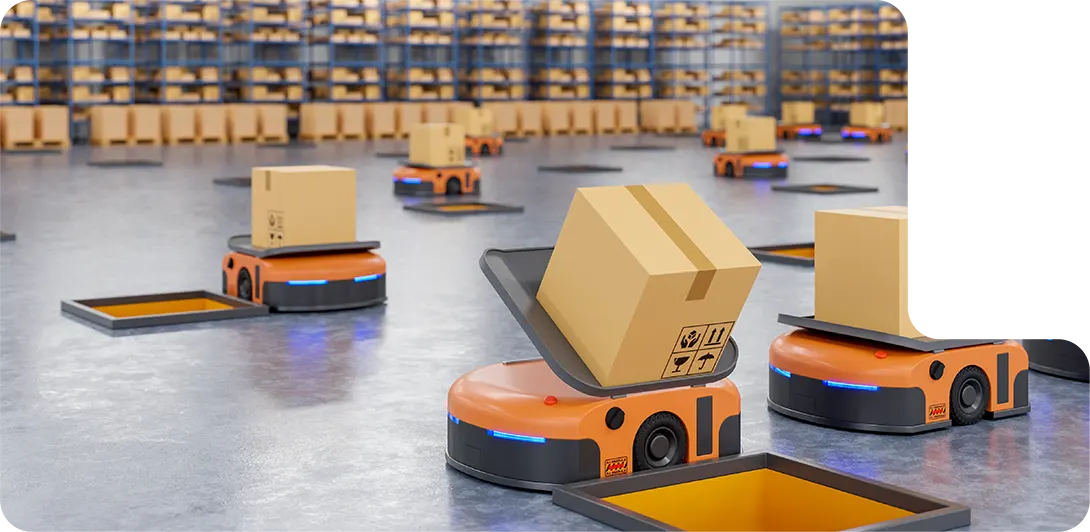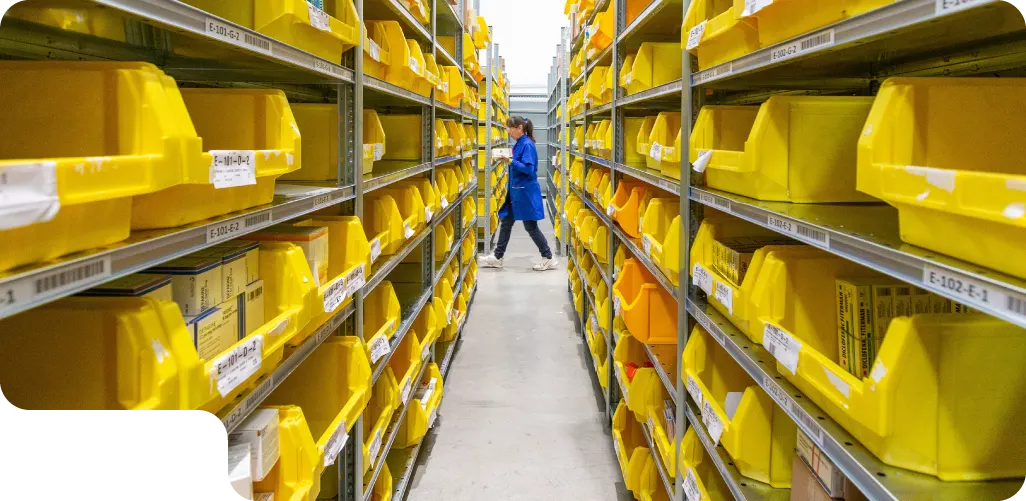Table of Contents
More Perpetual Inventory System Content
Share this
Subscribe to get the latest news!
Table of Contents
Share This
More Perpetual Inventory System Content
Subscribe to get the latest news!
Inventory is probably the most important and valuable asset of any business. Especially in an e-commerce business it’s important to maintain adequate inventory in storage to meet customer demands and ensure they are not overstocking and paying too much in storage costs. Keeping products in inventory for too long could also cause them to go bad or out of style.
In this article, you’ll discover everything you need to know about the perpetual inventory system that can help your business.

What is a Perpetual Inventory System
A perpetual inventory system is one of the best ways to keep an account of your inventory. In a perpetual inventory system, the moment the business makes a purchase or sale of new inventory, it is instantly recorded through computerized systems. A record of sale or purchase or any change in the stock is promptly recorded via an automated system. It will reflect the change in inventory in real-time, right at the moment of the transaction.
This method is known for its accuracy as it gives a detailed view of inventory changes and tracks how many sales and purchases have been made continuously.
Known for its accuracy, this method offers a detailed view of inventory changes and the count of sales and purchases at any given time.
It keeps track of the goods at hand and the cost of goods sold (COGS). This makes the perpetual inventory system the most effective and accurate inventory management and tracking system. It is also better than the older and preexisting inventory management method known as the Periodic Inventory System. In the later sections, we’ll compare and contrast the two.

How Does the Perpetual Inventory System Work?
Perpetual inventory system automatically records inventory count as soon as a purchase is made. Compared to periodic inventory, this approach is more accurate and efficient. Through the perpetual inventory system, whenever a product is sold, a point-of-sale (POS) system simultaneously updates the debit across all sales channels to the main inventory.
After purchasing or selling new inventory, the COGS (Cost of Sold Goods) also gets automatically updated. The system will also automatically update recorder points based on historical data and the decrease in sales, which will help you keep an optimum inventory level.
In some of these automated systems, you will not even have to order new inventory when stock is running low. If the system sees the inventory stock reaching a critical point, it will send a purchase order to the manufacturer without human intervention. Lastly, when new inventory stock arrives at the warehouse, the employees there will use a WMS (Warehouse Management Software) to scan the items, which will appear on your inventory management system, enabling their availability throughout all sales channels used. The perpetual inventory system does many tasks, making it an essential tool in running a business’s supply chain smoothly.

How Do Perpetual and Periodic Inventory Systems Work?
Inventory is a business’s biggest and most valuable asset. It refers to finished goods and raw materials that a company has in its hands for production or selling in the market. Since they are valuable goods, a company needs to account for all their inventory and keep track of it constantly. This will help the company track how many sales they have made and tell them when they need to refill their inventory, so the stocks do not run empty.
There are two main methods through which companies usually keep account of their inventory. The first one, we already know, is the perpetual inventory system, and the second one is the periodic inventory system.
Perpetual inventory method refers to keeping track of the inventory through automated processes that change the inventory count as soon as there is a new purchase or sale. Conversely, a periodic inventory system refers to the manual counting of inventory periodically. The first system is much more modern and accurate, but the second one is more cost-effective.
Perpetual Inventory System
This automated inventory accounting is performed through enterprise asset management and POS (Point-of-sale) systems. It is a highly comprehensive and sophisticated system that continuously keeps inventory tracking. It is also highly accurate because as soon as a new purchase or sale happens, it instantly updates it across all inventory channels.
Each product has a barcode, allowing the system to track its movement in and out of the facility and how long it has been on the shelves. High-end software takes care of updating all the movements of the products. Different ledgers in the system keep track of purchases, remaining stocks, and COGS (Cost of Sold Goods). This system needs high-end and costly infrastructure, which is why it is not very budget-friendly for smaller businesses.
However, if you want to scale up your company and cut back on the manual labor costs, implementing this system will mean you can cut back on prices in the long run. It is also a complicated system, but as it keeps constant track of the movement of products, it is highly reliable and accurate, which is vital for your business.
Periodic Inventory System
This is a much older system and is mostly used by small-scale businesses that do not have the money to spend on a highly advanced and automated inventory accounting system. As the name suggests, inventory accounting is done periodically and manually in this method. This could be a daily, weekly, or even monthly count, depending on how fast the business sells its products. A manual count is conducted at the end of the period.
The records of the purchases made are kept in the purchases account. After the count is over, new purchases are moved to the inventory, and the whole amount is recorded before the next period begins. And then the circle continues. This method is less sophisticated or accurate than the perpetual inventory method and is more time-consuming. But it is much more cost-friendly for smaller businesses on a tight budget.

What Are the Differences Between a Perpetual Inventory System and a Periodic Inventory System?
As we have already defined and explained the two inventory management systems to you, you have already figured out that they are, in fact, very different from one another. The main difference is something we already know. These two accounting methods are on the opposite sides of the spectrum.
In the perpetual inventory system, the accounting is done through high end-software, and the whole process is automated. Meanwhile, the periodic inventory system is done manually and periodically. Unlike the perpetual system, where all transactions are factored in immediately. But a few more factors separate the two.
Here is a breakdown of perpetual vs periodic inventory and the critical differences.
- The first and one of the key differences between these two processes is the type of businesses that use them for their inventory accounting. As we already mentioned, the perpetual inventory system can be very costly, and not every business can afford it. That is why it is mainly used by successful businesses and that are constantly scaling up. These companies have an extensive and complicated inventory that cannot always be accounted for manually. That is why it is the best system for larger businesses to use. On the other hand, smaller businesses that cannot spend a lot of their money on their inventory method use the periodic inventory system. Since they have smaller and less complicated inventory to account for, they can be taken care of by people periodically. The system isn’t the most advanced, but it is cost-effective.
- Since it is almost entirely automated, the businesses that use a perpetual inventory system do not have to worry about their inventory account. The system takes care of it all. Alternatively, companies using the periodic inventory system need to monitor that it happens on time and is accurate. There is more room for error in a manual system than in an automated system.
- The perpetual inventory system is highly accurate and fast. Since it uses real-time technology to update each one of the transactions in the system, it leaves no room for error. But the periodic inventory system, though perfect for small businesses, can take up time and manual labor. So you need to figure out when to jump from periodic to perpetual depending on how fast and how much your business grows.
- If your firm adopts a perpetual inventory system after installing the infrastructure and software, you’re all set. There are no manual labor costs involved after everything is in place. In contrast, if a business uses a periodic inventory system, they have to pay for manual labor and constantly monitor the accounts as there is a bigger room for error in a manual system.

What are the Advantages of a Perpetual Inventory System?
A perpetual inventory system is probably the best inventory accounting method for any e-commerce business. E-commerce businesses are vastly different from regular store-based businesses. They must accurately account for a lot of inventory as they continuously ship and receive items in and out of their stocks. That is why a perpetual inventory system is a perfect fit for e-commerce businesses. Here are some advantages that an e-commerce business owner can gain from implementing a perpetual inventory system.
- A perpetual inventory system continuously and ceaselessly updates any changes in your inventory in real-time. This means that your inventory count will always be accurate.
- Since you get accurate data about your inventory throughout your supply chain, you can always identify if any problem suddenly comes up in the system. In short, this system helps you optimize your supply chain as needed.
- A perpetual inventory system almost fully automates a lot of processes that will otherwise need manual labor to be fulfilled, it helps businesses cut back a lot on labor costs. The real-time updates also minimize the inventory holding costs, which would otherwise be high.
- Demand forecasting is a pretty complicated but essential process usually. The business has to predict the possible changes in demand according to historical sales data and ensure they have enough stock inventory to match the needs.
- This process is made a lot easier with the perpetual inventory system as it continuously keeps track of historical sales data and accurately forecasts the demands for different times of the year. This is a major advantage of perpetual inventory management systems.
- For accounting purposes, the data related to the end-of-the-year inventory balance needs to be accurate. With a perpetual inventory system, you get accurate data about your inventory at all times, even at the end of each year.

Who Uses a Perpetual Inventory System?
The perpetual inventory system is complex and uses expensive high-end infrastructure to facilitate inventory tracking. As we mentioned in the previous point, perpetual inventory systems are standard in larger businesses with vast and complex inventory to track. In comparison, businesses that have a smaller capacity use the periodic inventory system. The perpetual inventory system takes a lot of money to implement; that is why only more successful businesses use them.
Larger enterprises also have multiple inventory warehouses and locations, and the perpetual inventory system makes it much easier to keep track of their transactions than the periodic inventory system. Another type of business that uses the perpetual inventory system is those that usually have costly goods, such as jewellery and electronics. Losing these expensive items or not being able to track them accurately might result in huge losses. That is why these businesses use the technology-oriented perpetual inventory system as it is very accurate and keeps track of all the products and transactions in real-time.

When Would You Use a Perpetual Inventory System?
In the e-commerce market, the perpetual inventory system is the more suitable and sensible choice. If you are running a small business, however, you might not have the money to set up a perpetual inventory infrastructure. Small businesses also have a smaller and more manageable inventory. That is why if you have a small business with one inventory base, the best idea for you at the moment would be to use a periodic inventory system for your business. However, suppose your business is scaling up and has multiple different inventory storage locations. In that case, it might be time to upgrade to a perpetual inventory system as your inventory will become too complicated for a periodic inventory system.
If you implement a perpetual inventory system in your business, you will have an accurate and real-time account of your purchases and sales. You will not have to worry about a single thing. If you are doing business in the electronics or jewellery field, it is a good idea to implement a perpetual inventory system. These are expensive items, and you must keep track and have all the accurate data related to your inventory. Losing track of even one of your items may result in a loss. So plan your move at just the right time.

What is FIFO Perpetual Inventory Method?
The first in, first out, or FIFO, perpetual inventory method implies that retailing firms or supplies sell goods to production departments by manufacturing organizations in the particular order in which they are acquired. Furthermore, this cost flow happens within a perpetual inventory system, in which stock inflows and outflows are reflected in the inventory system as soon as transactions occur. Your corporation may discard or consume these products before selling them.
The closing balance of inventory indicates the most recent expenditures paid to acquire items or supplies under the FIFO inventory method. In other words, the costs of obtaining products or materials are deducted from revenues in the sequence they are incurred. The company records the sales in the ledger in the order they occur. Due to the precision and proper depiction of the company’s flow of goods, FIFO is a widely used cost flow tracking method today.
The FIFO inventory method has many pros; therefore, it is the default inventory method for most companies. Because the most recent purchases determine the cost of the inventory being sold, the FIFO technique saves money and time when estimating the exact price of the merchandise being sold.
It’s a straightforward concept that everybody can grasp. Managers with little or no accounting knowledge could learn it quickly. And lastly, it makes it impossible to manipulate the revenue provided in the financial statements since the FIFO strategy leaves no room for interpretation regarding the numbers to be utilized in the profit/loss statement’s cost of sales figure.

What is LIFO Perpetual Inventory Method?
Last-in, first-out (LIFO) is an acronym meaning last-in, first-out. It’s a stock valuation approach based on the assumption that the final products you place into inventory would be the first to sell at the beginning of a financial year. This implies you’ll check the most recent goods your organization adds to its stock when determining the products’ price.
When your expenses of purchasing inventory or manufacturing items have been rising due to variables such as inflation, you will employ the LIFO approach. While this inventory cost strategy may decrease your business’s revenues, it allows you to pay less corporation tax. The LIFO approach might help your firm save money if your stock and production expenses continue to rise.
Therefore, this method is not the go-to method for many companies. Since when to employ LIFO is highly dependent on market conditions, there is no need for businesses to utilize this strategy if prices remain stable. This is especially relevant because LIFO accounting is far more complicated than FIFO bookkeeping. Because some of your earlier goods may still be in stock, the COGS value you generate may not accurately reflect your inventory.
So make sure the LIFO approach is the best option for your firm before using it. Without the IRS’s authorization, you cannot change your mind once you’ve filed for LIFO. While LIFO is a more complicated alternative, it might result in significant savings if your firm requires it. Your corporation should consult a business tax consultant before making this decision, as it is a complicated procedure.

What is the Weighted Average Cost of the Perpetual Inventory System?
The Weighted Average Cost or WAC technique of inventory valuation in accounting employs a weighted average to estimate how much goes into COGS and inventories. The cost of products available for sale is divided by the number of units available to be sold using the weighted average cost approach. Both GAAP and IFRS accounting allows for the use of the WAC approach.
The formula for Weighted Average Cost is as follows:
WAC per unit = costs of goods available for sale/ units available for sale
In the above,
Beginning value of the stock + purchases equals the cost of products available for sale.
The number of units available for sale, often known as the total quantity of units in inventory, is determined as beginning inventory in units Plus purchases in units.
The average cost will be determined each time the average cost changes due to a new purchase in a perpetual inventory system. The accountants will calculate the new average cost when the firm purchases new inventory at a higher or lower price than the typical price.
Inventory and COGS are constantly tracked via a perpetual inventory system. The perpetual inventory method gives more up-to-date information for inventory management.
However, this kind of inventory tracking can be costly for a business. The weighted average cost approach is the “moving average cost method” in a perpetual inventory system.

Increased Usage of the Perpetual Inventory System
Using modern technology to keep track of the business’s supply chain is not a new idea. But it was not as easy to do it seamlessly. Processing the massive amount of data that goes into maintaining a large inventory was impossible with the technologies available back then. Properly maintaining a perpetual inventory system would take a tremendous amount of money and time. That is why most businesses employed the periodic inventory system.
But times have changed now. The new technology needs little to no time to update all the real-time information in the system after a transaction is made. This means that the moment goods are purchased or a product is sold, the system instantly updates that data across all the inventory sales channels, and it is recorded for future use.
Not only does this mean that the COGS and inventory data are continuously updated but also that whenever the company needs to use the sale data to predict the sales or forecast demand, they can do so instantly. That is why, in the last few years, many companies have started using the perpetual inventory system instead of the periodic inventory method.
Even though it takes a lot of money to set up the infrastructure to maintain a proper perpetual inventory system, it also means that the inventory management process becomes hassle-free and rarely needs human intervention. The method is sophisticated, accurate, and constantly processing and updating data. It has opened up a new path for the e-commerce market.

Optimizing Perpetual Inventory Systems for Retail Chain
The perpetual inventory system can greatly help your business when you implement it. However, you can optimize the system and tailor it to fit your business perfectly. Every company has a different set of requirements that need to be fulfilled. Listed below are some ways to further enhance your inventory management system.
- Firstly, you must ensure that your warehouse storage location is optimized; this simplifies the fulfilment process. Try to hire a warehouse space that is easily accessible through multiple transportation channels. Not only that, but you also have to make sure that in the warehouse itself, your bestselling items are always placed at the front, so they are more easily accessible at the time of picking and packing.
- Establishing key metrics and KPIs is critical to growing your business. These metrics are accurate data related to your supply chain that will help you identify the weaknesses in your supply chain and help you make the necessary changes. This is one of the best ways to optimize your inventory and supply chain.
- If you want to increase your income, you must first increase your sales. Sometimes, some items do not get sold for a long time. Not only do they take up storage space, but also, as time goes by, the products might go out of fashion or become obsolete.
- That is why, if your inventory system shows you that some products have been sitting in your inventory for a long time, you should arrange a sale for them at a lower price so customers will be attracted to them and buy them. That way, you can clear the storage space and make money.
Conclusion
The perpetual inventory system is the inventory accounting method of tomorrow. Not only is it competent but also fast and secure. If you implement it in your business, you will not have to worry about constantly keeping track of your inventory. The data the system will provide will also be accurate.
Sign up today and LEAVE THE LOGISTICS TO US
Sign up, and we will get back to you within 24 hours to discuss what services would be best for your business needs. Or speak with us now and tell us what you need.
FAQs
The Perpetual Inventory System is an inventory accounting method that uses a POS (Point-of-sale) system and software to keep track of incoming and outgoing inventory continuously. It updates the data every time a transaction is made and is a highly accurate inventory accounting method.
Periodic Inventory System is an older inventory accounting method that periodically does physical counts manually to keep track of inventory. It is a more cost-effective method. The downside is that it is not as accurate as a perpetual inventory system and takes longer.
In a perpetual inventory system, your inventory count is constantly updating and highly accurate as it uses real-time technology to update the data constantly. You can also gather a lot of data related to sales and predict the market demand for your products for the upcoming year.
Small businesses might not have the capital to set up a perpetual inventory system. The perpetual inventory system is perfect for larger businesses with a complicated inventory setup that is hard to account for through physical count.
The perpetual inventory system is becoming increasingly accurate and fast through newfound technology. It can handle and process a massive amount of data in a matter of seconds. It is a highly efficient method that is improving every day. That is why a lot of e-commerce businesses are choosing this method.
The following are the key distinctions between FIFO and LIFO method:
- The first-in, first-out (FIFO) technique posits that the oldest inventories are sold or consumed first in production.
- The LIFO technique presupposes that the most recent purchases or fresh inventories arrive first and are sold or utilised in production first.
- The FIFO technique is a widely used accounting approach that both GAAP and IFRS have recognised.
- GAAP permits the LIFO approach, while IFRS forbids it.
- The FIFO technique is a rational strategy to reduce inventory losses due to obsolescence – expired or stale products for production or sale — by following the natural inventory flow.
- Because of obsolete or damaged items, the LIFO approach might result in inventory losses.
FIFO is the most commonly known and approved value approach for inventory management. It’s safer, simpler, and more cost-effective in the long term than dealing with LIFO’s ambiguity and potential profit loss. Nevertheless, both systems have benefits and drawbacks. So go through each one thoroughly before deciding on which method to use.
When using the perpetual inventory method, journals are processed each time there is a transaction to record the change. Inventory is debited for purchases and credited for sales, with the debit flowing to the cost of goods sold.
In general, the perpetual inventory system is, in fact, better than the periodic inventory system and outperforms it. That’s because corporations’ software program makes it a hands-off, low-effort procedure.
Barcodes help track items or goods from shelf to sale using point-of-sale equipment. These barcodes give businesses the data they want on individual items, including how long they lay on shelves before purchasing. In addition, perpetual inventory methods preserve precise records of the cost of items sold and purchased.